Valuation and sale of inheritances, estates, or collections
Do you have an estate that you wish to sell? Are you the beneficiary of a large collection and would like to have it professionally valued?
Lempertz offers a unique and accessible service should you wish to have your estate, inheritance, or collection valued or sold. Our team of professional art specialists will provide you with discreet and non-binding advice and are available to answer any questions you may have. Our diverse online and offline marketing instruments ensure that we reach a broad international customer base and secure you the best possible sales success.
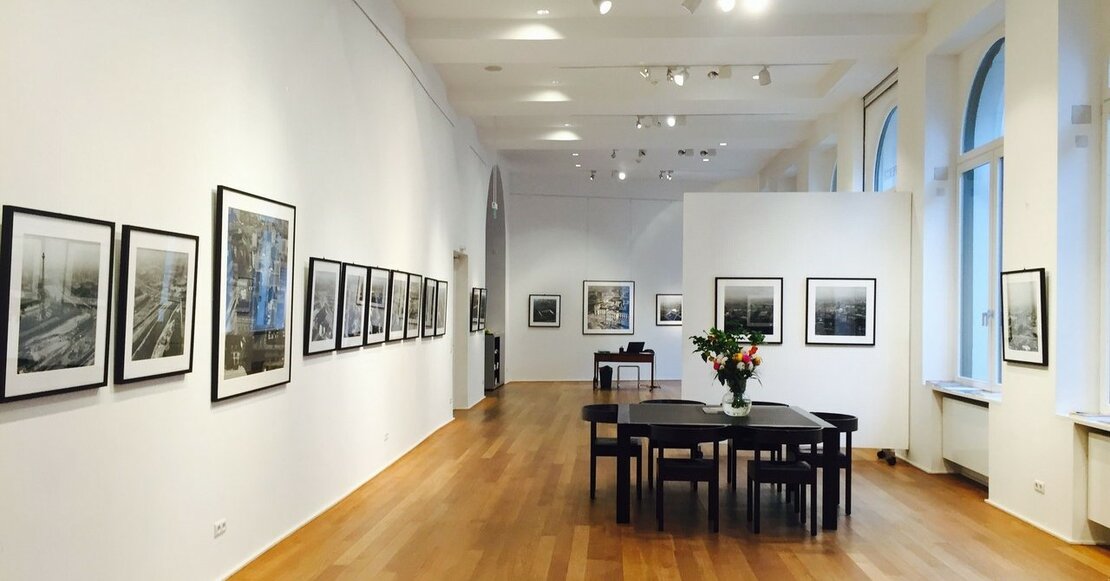
Collections Sold
In spring 2019, we were able to successfully sell numerous top quality works by Günther Uecker, Imi Knoebel, Max Liebermann, and Günther Förg from the great collections of German industrialists and banks. For many especially important collections we also produce lavish stand-alone catalogues, organise exclusive previews, and hold single owner sales.
Abraham and David Roentgen
Roentgen furniture from Neuwied – also once of royal interest has stood as an international symbol for quality for 250 years. In the half-century from 1750 to1800, Abraham Roentgen and his son David produced technically advanced furniture of extreme elegance. Their finesse and functionality won over all the European royal courts. Louis XVI awarded David the title ‘Ebeniste Mecanicien du Roi et de la Reine’ whilst Catherine the Great blindly bought his goods. On 13th November 2020, sixteen pieces of furniture by these two important German ebenistes of the 18th century were auctioned.
From their consignment onwards, all collections at Lempertz are subject to strict examination, appraisal, and cataloguing procedures – always involving extensive exchange with the collector and their collection. It is precisely this joint exchange which is an essential building block of the collection and its auctioning, as Lempertz often accompanies the collections for years or even decades and thus is able to oversee their dynamic changes.

The exceptional Bernard De Leye Collection
Like every collector’s personality, every artwork has a biography and a story. This is particularly clear with the exceptional Bernard De Leye Collection, auctioned by Lempertz on 15th July 2021. With its exquisite ‘Wunderkammer’ (cabinet of curiosities) objects from the 13th to the 19th centuries, the auction was not only a highlight of that auction year. L´Orfèvrerie, the art of gold and silversmithing, was De Leye’s lifelong passion – a field in which he is known during his lifetime around the world as a leading connoisseur, collector and art dealer.
The auction encompassed more that 200 works of art: Objets de vertu, silver works, paintings and sculptures, including pieces of the highest museum and historical-quality and overwhelming beauty: objects commissioned by kings, the court of the Russian Tsar and high-ranking nobility, and created by prominent artists. The elegant French culture of the 18th century was surely a theme of De Leye’s passion.
The top lot of the auction also arose from this era: a silver-gilt lavabo set which King Louis XV of France gifted in around 1770 to his former mistress Marguerite-Catherine Haynault and her later husband, the Marquis de Montmelas as a wedding present. Made by Jean-Baptiste François Chéret, the set made 1 million euros.
Alongside his liaison with Mademoiselle Haynault, King Louis XV also had an official mistress, the Marquise de Pompadour. Given De Leye’s skills in collecting, it is no surprise that the silver-gilt washbasin commissioned by the king for the Marquise was part of Lempertz’ auction. The same is also true for a further unusual gift, that of writing utensils in the form of a ship which Louis XV gave to his seal bearer Jean-Baptiste de Machault d’Arnouville in 1752.
In addition to the focus on the royal art of French Absolutism, De Leye often enriched his collection with unusual pieces of Gothic and Baroque sculpture from Italy and Flanders.
The highlights of the auction from the field of ecclesiastical art featured a very finely worked amber altar from the treasury of the Einsiedeln Monastery in Gdansk. The altar was made of light, dark and translucent amber as well as ivory and is attributed to the sculptor Christoph Maucher of Gdansk. It was sold to a Belgian collection for 325,000 euros.
To reflect the exceptional unique works, the catalogue of the special auction was equally elaborate and richly designed and is still coveted today by collectors of historical gold and silversmith art as well as by art lovers. This collection, assembled with great connoisseurship, achieved a total of 5.3 million euros at auction. Antiques of this outstanding abundance, quality and importance had not been offered on the German market for decades.

The netsuke of the Brockhaus Collection
This is also the case of the Brockhaus Collection. The former Lempertz employee and expert for Asian art, Trudel Klefisch, in particular, dedicated herself intensively to the collection. Mrs Klefisch began her apprenticeship at Kunsthaus Lempertz in 1963. She first came into contact with the Brockhaus Collection in 1980 when she was approached by the police in connection with the theft of netsuke from the premises of the Brockhaus publishing house in Wiesbaden. Her employment as an expert witness of the seized goods acquainted her with Albert Brockhaus’ grandchildren for the first time. This developed into a long relationship between his descendants and Trudel Klefisch herself.
Lempertz offered netsuke from the Brockhaus Collection a total of six times, lastly in 2019, when two great-granddaughters of Albert Brockhaus expressed their intention each to sell 100 pieces from this most famous German netsuke collection. Mrs Klefisch received each of the 200 netsuke carefully packaged, labelled and classified, and was particularly pleased that this exquisite collection had crossed her path one more time at the end of her professional life. Like all items offered for auction, the netsuke are also presented in auction catalogues.
In some cases, these catalogues bring together collections and individual consignments, and in others, a separate catalogue for the individual collection is compiled. The catalogues are of high quality and professionally put together and offer the consignors a bibliophilic, attractively designed overview of the collection and thus also serve as a beautiful souvenir. For the buyer, the catalogue provides a reference to the purchased object, not least of the exceptional provenance.

The Jacobs Collection
An exceptionally noteworthy catalogue was produced for the auction of the Jacobs Collection on 16th November 2021. Here, the name of the game was that of probably the most famous German coffee manufacturer. The collection comprised the finest silver, playful porcelain, dazzling paintings and expressive drawings, whilst the common theme of these artworks was also reflected in the dark brown catalogue design: coffee.
The selection of art objects allowed both the staff at Lempertz as well as the recipients to understand and experience the centuries long cultural-historical development of coffee and its resonance in art history. This auction offer was made possible by the thematic expansion of the Johann Jacobs Museum in Zurich with the owners having decided to part with a fragment of the collection. Dynamic collecting requires a certain sovereignty from private as well as institutional collections to part with pieces once in a while in order to create room for something new.
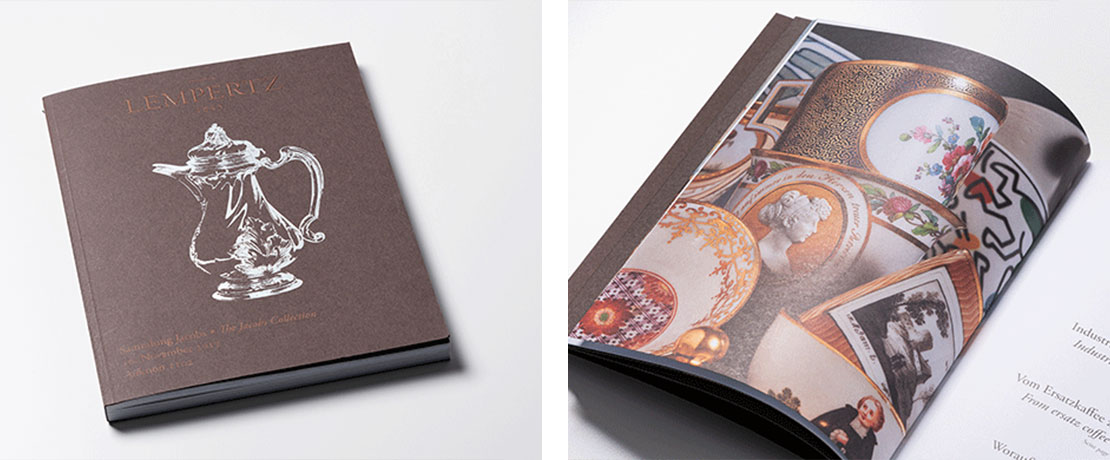
Private Collection of Orsola and Filippo Maggia
In the Photography Auction of 7th December 2020, Lempertz offered the highly important Private Collection of Orsola and Filippo Maggia in a special catalogue titled ‘Rome in Early Photographs’ which consisted of eighty rare, captivating views of Rome from the mid-19th century.
The exceptionally well-preserved photographs of the most famous ancient monuments of the Eternal City, including many salt paper prints, appealed not only to photography enthusiasts, but also to lovers of all genres of art with a passion for Italy. Compiled over three decades with great care and expertise, the collection had been on loan to the Fotomuseo Giuseppe Panini in Modena between 1990 and 2017, where it was presented from January to March 2008 in an exhibition curated by Francesca Bonetti (Istituto Nazionale per la Grafica, Rome).
In its thematic breadth and the diversity of early photographic processes, the collection allowed a decided insight into an important chapter in the history of photography. Until the mid 19th century, local painters, engravers, and lithographers had met the tourist demand for city views of the popular destination on the so-called ‘Garand Tour’. However, it took no more than a decade after the invention of photography in 1839 before the camera was considered the most suitable medium for producing detailed and topographically accurate depictions of Rome.
In around 1850, the city thus became a melting pot of early, very productive photographic scenes with the ‘Scuola Romana di Fotografia’ at its centre. The selection of photographic works in our special catalogue enabled a vivid understanding of all of these important photo-historical backgrounds.
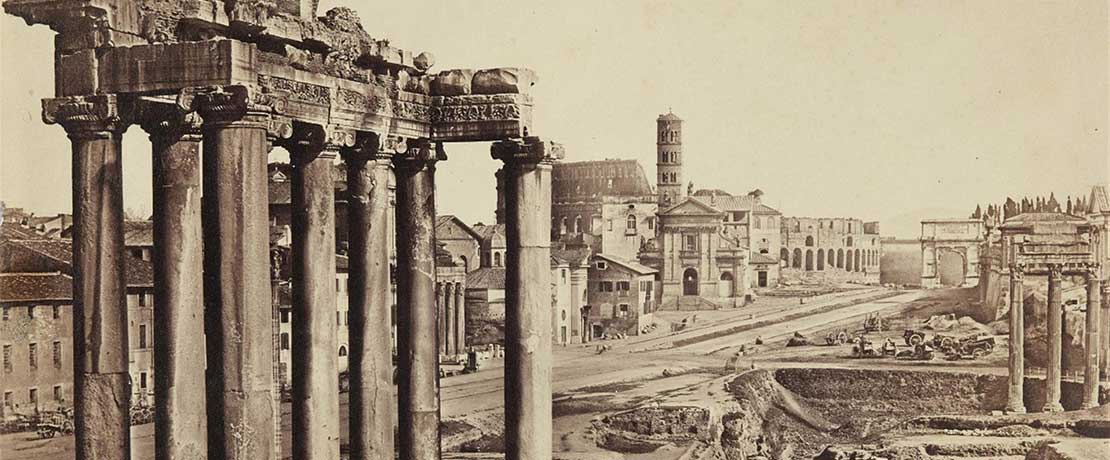
Corporate Collections – a selection
The auction of modern works of art from the Kaufhof Corporate Collection caused an unexpected media sensation. The top lot of the auction of 31st May 2019 was Max Liebermann’s 1909 monumental painting ‘Judengasse in Amsterdam’ which sold for 1 million euros.
The painting had been acquired in 1954 by Werner Schulz, the art-enthusiastic CEO of Kaufhof, as a memento of the company’s founder, Leonard Tietz. The haggling over goods that Tietz’ friend Liebermann observed in the Jewish quarter of Amsterdam after the turn of the century had become a thing of the past in Germany with the emergence of the first large department stores.
The auction achieved several million euros from around forty works from the art collection which had hung for decades in the former company boardroom in the Leonhard-Tietz-Straße in Cologne – including works by Imi Knoebel, Günther Förg, Kenneth Noland, and Heinz Mack with a noteworthy large format wall mosaic made of glass mosaic stones. In the course of the corporate merger of Galeria Karstadt Kaufhof, the sale was symbolically agreed.
In the Contemporary Art auction in December 2016, Lempertz saw numerous record prices with works from the Portigon Collection (formerly WestLB) and the IKB Deutsche Industriebank AG. ‘Große Flora D’ by Fritz König, stood in the city centre of Dortmund since 1980, providing an intense contrast to the straight-lined, inanimate building facades behind with its reduced, strikingly organic-looking geometric forms. With a result of 568,000 euros, the Portigon sculpture achieved an international record price.
Works from the important collection of the IKB Deutsche Industriebank AG included two ‘Farbraumkörper’ from Gotthard Graubner, two significant nail pictures by Günter Uecker, and works by Katharine Grosse and Imi Knoebel. The highlight of the auction was Josef Albers’ ‘Homage to the Square’ from 1962. In the characteristic nest of three coloured squares –here in shades of blue and green – the result of 676,000 was a new German record price for the artist, whilst a then international record price was seen for a ‘Farbraumkörper’ by Gotthard Graubner with 580,000 euros.
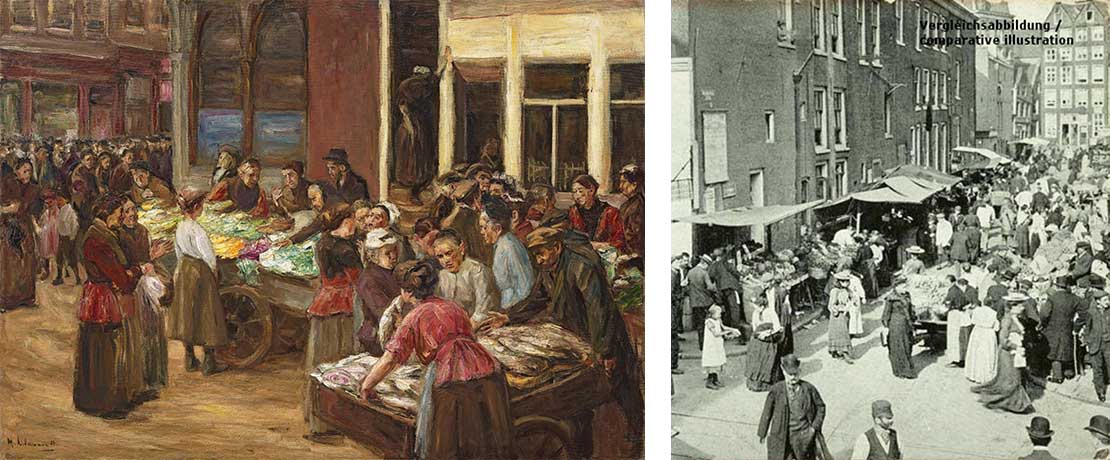
Old Masters acquired by the Bremen collector couple H. and I. Bischoff
An at least comparable response was generated by the sensational collection of Old Masters acquired by the Bremen collector couple H. and I. Bischoff. They had been associated with Lempertz for decades as one of Europe’s market leaders in the field of Old Masters, and thanks above all to the professional expertise and decades of experience of Lempertz’ experts, it was possible to acquire a collection of such significance for an exceptional auction. This was the most outstanding auction of Old Masters in Germany since the Frank Collection, also auctioned by Lempertz in 2012, which not only brought in a top result, but at 3.785 million euros for a painting by Gerard Dou, also the highest result achieved for an Old Master painting in Germany.
The 23 masterpieces from the Bischoff Collection, previously exhibited in many European museums, formed the highlight of Kunsthaus Lempertz’ 175-year anniversary, and was auctioned on 8th December 2020.
Outstanding objects included paintings by Georges de La Tour, Marinus van Reymerswale, Quentin Massys, Philips Wouwerman, Conrad Faber von Kreuznach, to Edouard Vuillard and Lovis Corinth. The highlight of the collection and the high point of the German auction season was the last privately owned ‘nocturne’ by the exceptional painter Georges de La Tour (1593–1652), the great Lorraine Master, from whom only around fifty paintings have been authenticated. His equally quiet and enigmatic paintings are among the ‘must haves’ of the world’s most renowned museums. Painted between 1646 and 1648, ‘La Fillette au braisier’ (Girl Blowing on a Brazier) was acquired by Bischoff in 1975 with an incomparably sure instinct.
In the years that followed, it was presented in countless museum exhibitions throughout Europe, including the Grand Palais in Paris, and the Museo Nacional del Prado in Madrid (result: 4.43 million euros).
Another star lot of the auction was the painting ‘The Moneylender’ by the Dutch painter Marinus van Reymerswale (circa 1497–1567) – the only known painting by his hand on this theme as originals by this eccentric and time-critical artist are extraordinarily rare. The painting is the most important picture by Marinus van Reymerswale to be offered on the international art market in the last thirty years and was sold for 325,000 euros.
Hinrich Bischoff was a successful entrepreneur in the aviation industry (among other things as founder of the ‘Germania Fluggesellschaft’), and a passionate collector who acquired an enormous knowledge and much-admired connoisseurship in the field of Dutch and German painting of the 16th and 17th centuries. Both characteristics formed the guidelines of his high carat and noteworthy collection. In total, the Bischoff Collection achieved a total result of 8.4 million euros.

Die Twinight Collection I & II
In autumn 2018 and spring 2019, the renowned Twinight Collection of the New York businessman Richard Baron Cohen came under the hammer. The collection, which was without doubt the largest and most important private collection of early 19th century porcelain in the world, achieved a total of 2.46 million euros at auction.
The passionate collector travelled the world for many years, visiting international auction houses and renowned art dealers in order to complete his collection. Finest quality products and royal commissions from the manufactories of Royal Berlin, Sèvres, and Vienna made the Twinight Collection a world class museum quality collection, and it was shown in several solo exhibitions at the Metropolitan Museum in New York, Schloss Charlottenburg in Berlin, and the Liechtenstein Museum in Vienna.
Lempertz produced sumptuous stand-alone catalogues for the Twinight Collection I and II and arranged lavish previews in Vienna, Munich, Cologne, Berlin, and Brussels, as well as an exclusive dinner event with engaging speakers for a select circle of clients.
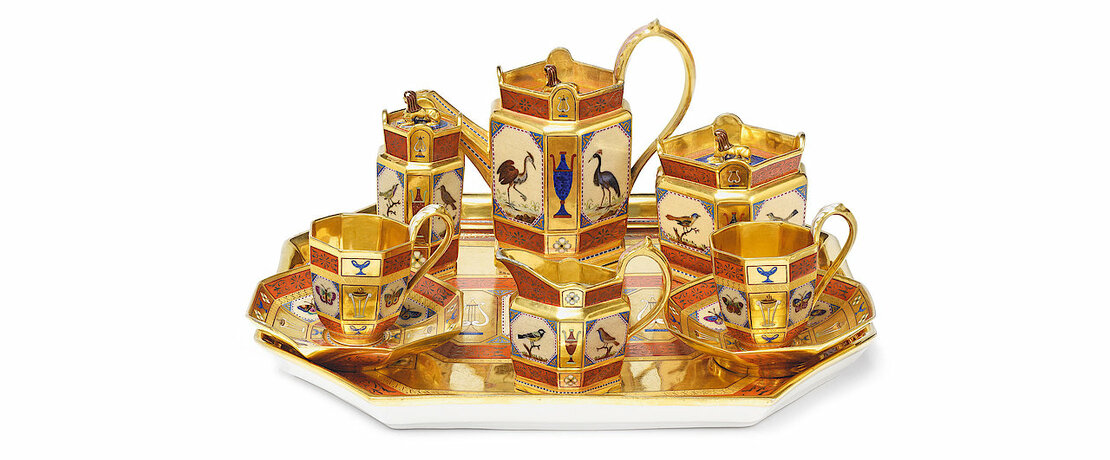
Private Collection of Renate and Tono Dreßen
Art objects made of porcelain and glass from the 17th and 18th centuries from the Private Collection of Renate and Tono Dreßen were also offered for sale in the 2020 autumn season. The Münster building contractor Tono Dresen (1931–2019) had built up a widely respected collection over the course of more than forty years, which was exhibited in the Lackmuseum in Münster and received wider publicity after its publication in 2018 by the Deutscher Kunstverlag under the title ‘Blütenlese’ (Florilegium).
Tono Dreßen’s love of porcelain began in the 1970s with a focus on tableware. Pieces offered from the collection included, among others, exceptional armorial porcelains and service pieces in the finest early fond colors with over forty individual porcelains from the important service consignments to the European courts, and the most beautiful decorations from the early Hoeroldt workshop.
The highest price amongst the almost completely sold Meissen porcelain selection, with a sales rate of over 130% by values, was achieved by an exceedingly rare writing set modelled as a farmhouse in 1741 by Johann Joachim Kaendler and Johann Gottlieb Ehder. The bronze mount was probably added in Paris in 1755. The rarity was intensely fought over, selling eventually for 47,000 euros to a German collector – after an estimate of 6,000 euro.
Another meteoric rise was achieved by a 20 cm long spoon with the coat of arms of Anna Maria Luisa of Medici from before 1743, which escalated from 1,000 euros to 31,000 euros. The impressive collection with 17th and 18th century glasses was much in demand and fetched 185% by value with prices up to 18,000 euros.
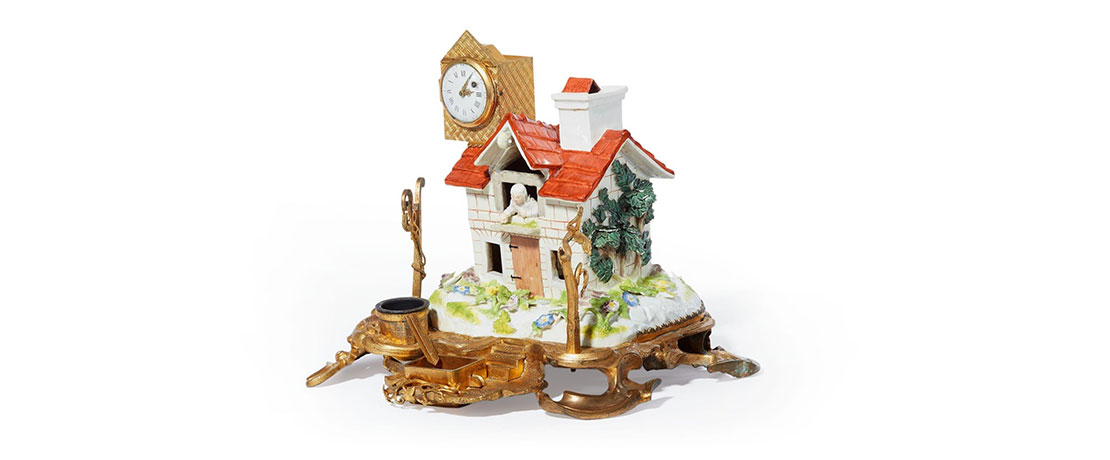
The Estate of Will Grohmann
Will Grohmann, born in 1887, was an important German art historian and critic of the 20th century, He fostered close contact to the young painters of the ‘Brücke’ art group and was an important patron of the Bauhaus movement. Grohmann counted numerous artists amongst his friends, including Ernst Ludwig Kirchner, Karl Schmidt-Rottluff, Otto Dix, Paul Klee, Wassily Kandinsky, Oskar Schlemmer, Willi Baumeister and Hans Hartung. Renate Glück, the sister of Grohmann’s wife Annemarie, was a respected collector who cultivated artist acquaintances throughout Germany. After the death of her brother-in-law, she continued the responsible management of his estate.
On 29th/30th November 2019, thirty works by pioneers of abstraction, with high-calibre works of the avant-garde and post war modernism from Will Grohmann’s estate, were auctioned by Lempertz with great success. Included in the sale were paintings, watercolours, drawings and sculptures by Arp, Baumeister, Kandinsky, Klee, Miró, Winter, Albers and Hartung – some with personal dedications to Grohmann. This important offer was completely sold, with a number of considerable price rises.
Estate of August Haseke
Lempertz also sells collections of contemporary art to great success, time and again. One example is the important Estate of August Haseke (1932-2018), which was auctioned on 2nd June 2018. Haseke was particularly in demand not only for his important works of art; he is also connected to a significant part of post-war art history. With the opening of his galerie h in Hanover in 1965, and his ideas on the democratisation of art in the form of prints and multiples, Haseke moulded the resurgent art market of 1960s Germany, making him one of the pioneering gallerists of the time.
During his studies at the state Art Academy in Düsseldorf, Haseke formed important contacts with later art greats. In the 1960s, he opened galerie h with an exhibition by Gotthard Graubner, followed a little later by the now legendary joint exhibition of Sigmar Polke and Gerhard Richter. The catalogue published by Haseke became a sought-after artist’s book due to documents and photographs of the young artists. Alongside colour field theory, a new realism emerged that called itself capitalism, and thematically analysed painting as a medium beyond classical painting, for example with photographic means. Sigmar Polke, Gerhard Richter and others immersed themselves in the social economic miracle, questioning critically and sometimes ironically the new perception of the immobilized citizens.
Haseke expanded his field of activity to include the publication of prints, thus underlining the upswing in artists’ prints from the late 1960s onwards. He ended his gallery work in 1970 and handed over his address index as well as ‘his’ artists such as Girke, Graubner, Polke, Richter, Calderara and Reusch to Joachim Ernst, with whom he had worked closely over the previous few years in Hanover. Haseke continued his work as a schoolteacher, first moving to Mönchengladbach and later to Viersen on the left bank of the Lower Rhine. In 1975, Haseke moved again, this time to Cologne, where he died on 26th January 2018.
The very successfully auctioned editions, watercolours, sketches, designs and projects by Antonio Calderara as well as prints and multiples by Sigmar Polke, Gerhart Richter, Zdeněk Sýkora and Günther Uecker, all came from the gallery owner’s estate.
Book and Print Collection of Werner Floss
Less epochal than thematically orientated, the broad spectrum of illustration art was made accessible by Venator & Hanstein on 24th March 2022 in the course of the sale of the Book and Print Collection of Werner Floss. The core of the collection encompassed illustrated books dating from the end of the 19th century up to the present day in German language publications. In addition, a small collection of travel literature, in particular travel reports on discoveries in Africa were also auctioned.
Furthermore, the collection offered a few scientific works and literature from the 17th and 18th centuries as well as modern prints. Werner Floss gathered illustrated books and illustrative series with knowledge and passion. His main area of interest lay in illustration from the end of the 19th century, starting with English and French models, May Klinger and Viennese book art around 1900, up to the present day.
Illustrated books of the 1920s were represented in his collection in a density and completeness that must have been unique. Many editions were present in different variants, mostly in advance copies with suites, and in various bindings by master bookbinders. Preliminary drawings and drafts of book illustrations, some of which never went to print, were also represented in the collection.
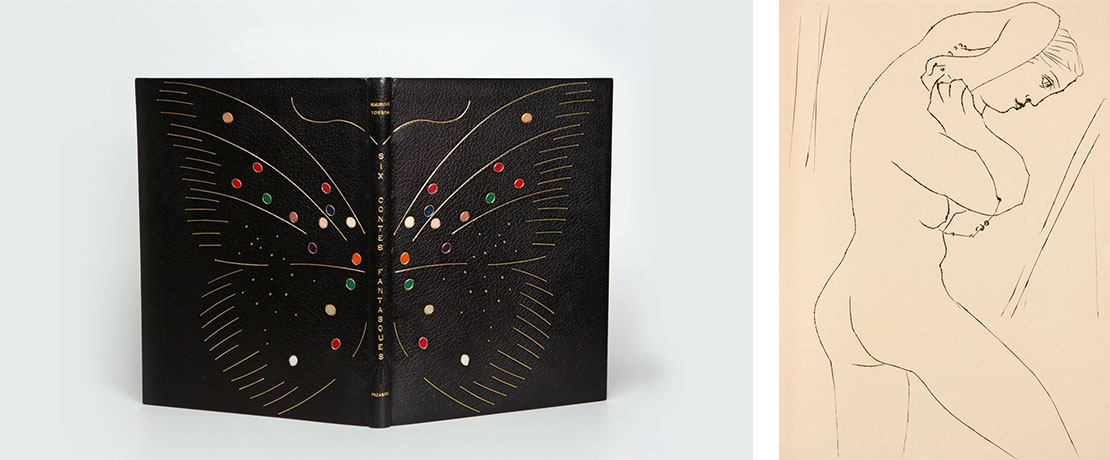
Collection of Gottfried and Helga Hertel
Equally passionate and interested in a subject as Werner Floss were Gottfried and Helga Hertel. They not only collected art, but they lived it. Gottfried Hertel, managing director of the German Nuclear Reactor Insurance Pool founded in 1957 with its base in Cologne, was an enthusiastic old-school collector who was intensively involved with diverse acquisitions until the end of his life, always on the lookout for evidence of early cultures. His first purchase in 1980 was a Chinese archaic gui-type bronze. He was fascinated by bronzes and their inscriptions and was always in close contact with scholars at the Academia Sinica in Peking. His interests were wide-ranging and included Chinese painting, archaic jade, ceramics and porcelain as well as Koran and Japanese art (woodcut prints). The Collection of Gottfried and Helga Hertel was auctioned by Lempertz on 6th/7th December 2019.
Staying in the field of Asian Art, one object in particular has stood out in recent years: In the autumn season of 2018, Lempertz achieved the highest hammer price that auction year in German and the highest price for a comparable object in recent years with a Chinese ge-dish from the Collection of Dr Otto Hasse (Hachez Chocolate). As the lot was called, silence spread across the crowded, lively auction room. 150,000 euros was called, and in addition to room bidders, nine telephone entered the bidding ring and fought for the winning result. The bids rose in 20,000s, 30,000s, 40,000s and finally 50,000s over the 100,000 mark, passed 500,000 euros – and only ended finally with a result of 1.125 million euro for the imperial piece, which then returned to China.
This outstanding ge-dish of the Southern Song/Yuan period (1127–1368) shone out from the considerable German collection of 21 pieces of ceramics and decorative arts. Craquelure stoneware from the Southern Song dynasty (1127–1279) has been surrounded by an aua of mystery for centuries. Connoisseurs of the Yuan and Ming periods dedicated texts and poems to its beauty and elegance.

Highly Important Mortars from the Schwarzach Collection
Highlight of spring 2019 was the sale of the Schwarzach Collection of Europe's most important mortars. The collection was presented in a detailed stand-alone catalogue and sold almost in its entirety. The 115 mortars making up the collection originated from Europe and the Near East and spanned 1000 years of history, with examples ranging from the 8th to the 18th century. The highly successful auction saw the sale of almost all of the objects on offer, with many achieving prices far above their estimates.
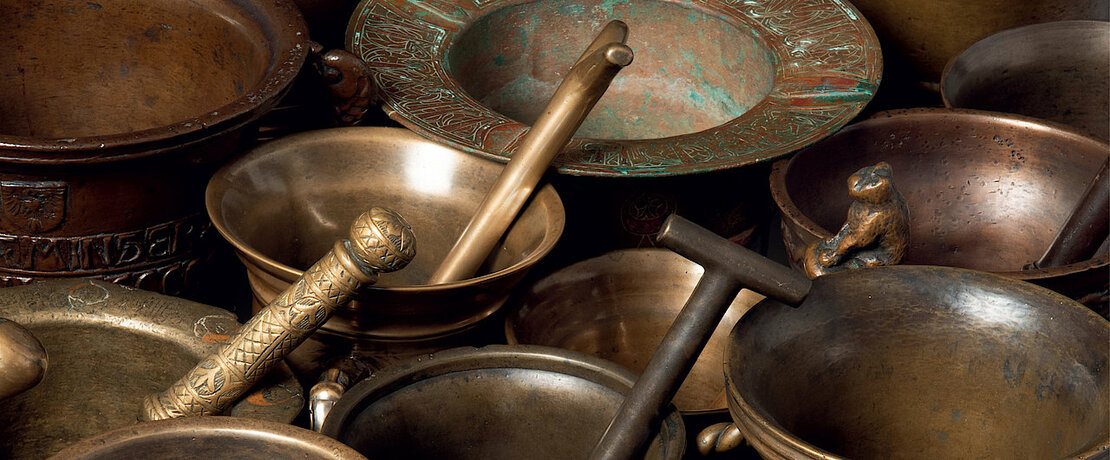
The Klaus J. Jacobs Collection
In autumn 2017, the sale of the Klaus J. Jacobs Collection attracted a lot of attention and achieved a total result of 2.7 million euros. Alongside numerous record prices, many objects rose far above their valuations.
In 1984, Klaus J. Jacobs started a very special collection: That of the Jacobs Suchard Museum in Zurich. Jacobs wanted to curate a collection documenting the history of coffee in Europe, and amassed a remarkable selection of artefacts illustrating the cultural history of the product. The collection included over 250 objects, all relating to coffee, including paintings by Georges Braque, Lesser Ury, and George Grosz as well as exceptional coffee pots, cups, and machines dating from the Baroque to the Bauhaus.
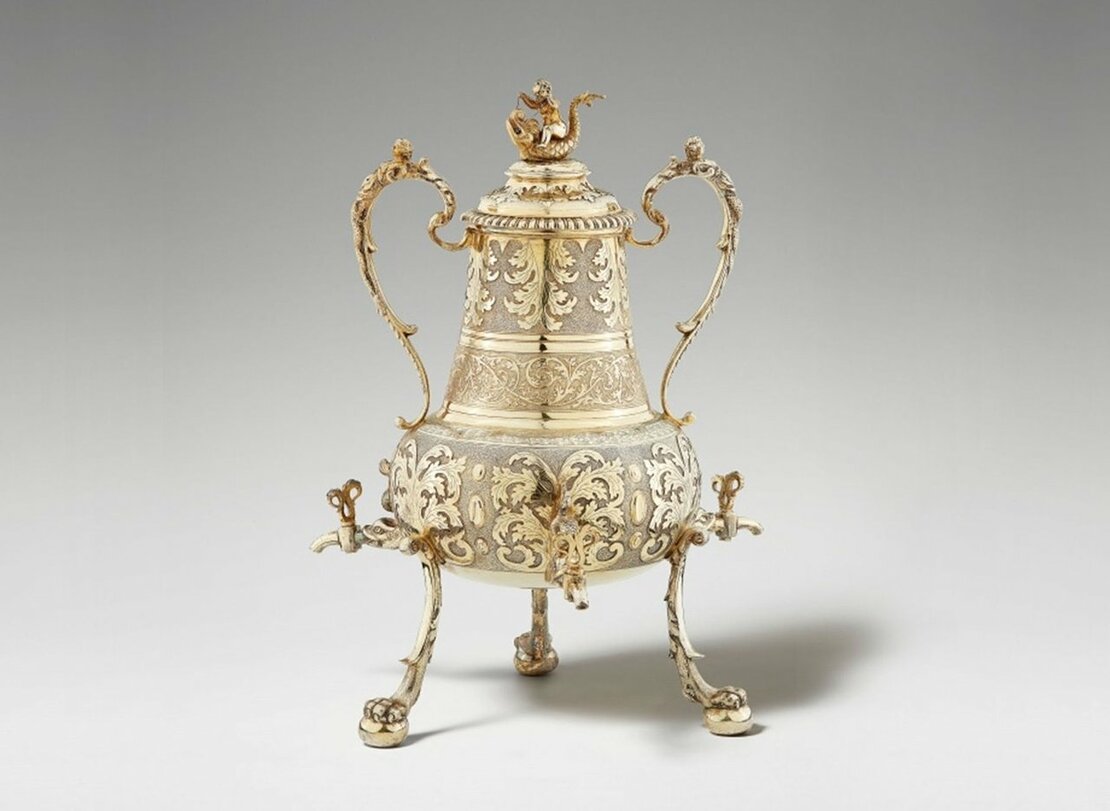
The Pioneer of Photography - A collection of 60 photographs by Heinrich Kühn
An important collection of 60 photographs by Heinrich Kühn achieved exceptional success in autumn 2017. The rare and fine quality group of works attracted numerous national and international buyers, including renowned museums. The high level of interest led to some exceptional price increases and a result by value of 80% over the original estimate. With this sale Lempertz was able to establish a new price level for works by Kühn in Europe.
A collection of 60 photographs by Heinrich Kühn was also successfully sold in the 2017 autumn season. Read our exciting Academy report here: “The extremely delicate nuances of lighting effects”, on the photography of Heinrich Kühn.
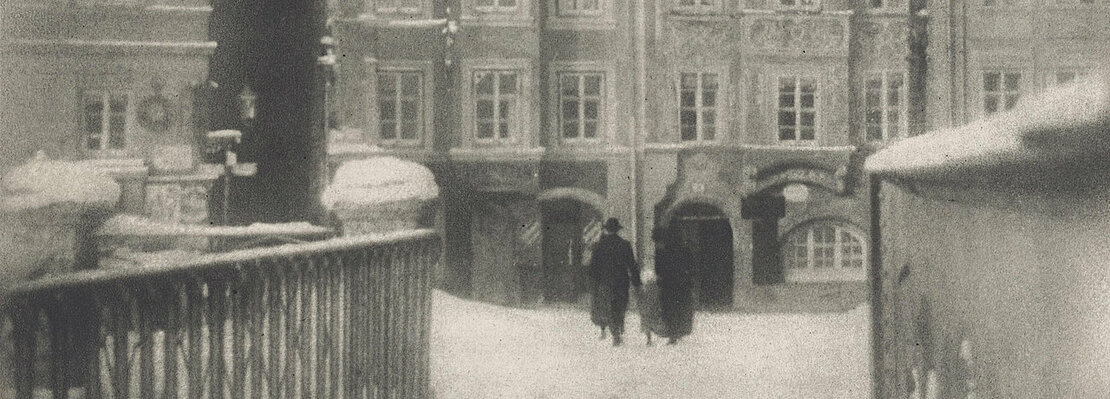
Netsuke Collections
In the previous years we have had the great pleasure of auctioning two large and important collections of netsuke. The small, finely carved Japanese figures have recently been experiencing an increase in popularity. The Kolodotschko Collection was separated into several, often very exclusive, sales due to its exceptional size. The last part was sold in spring 2017 with great success. Spring 2018 saw the successful sale of the Papp Collection of netsuke in Cologne. If you would like to learn more about netsuke, read our fascinating Lempertz-Academy report for more about the origin and original meaning of these Japanese collectors’ items: Netsuke
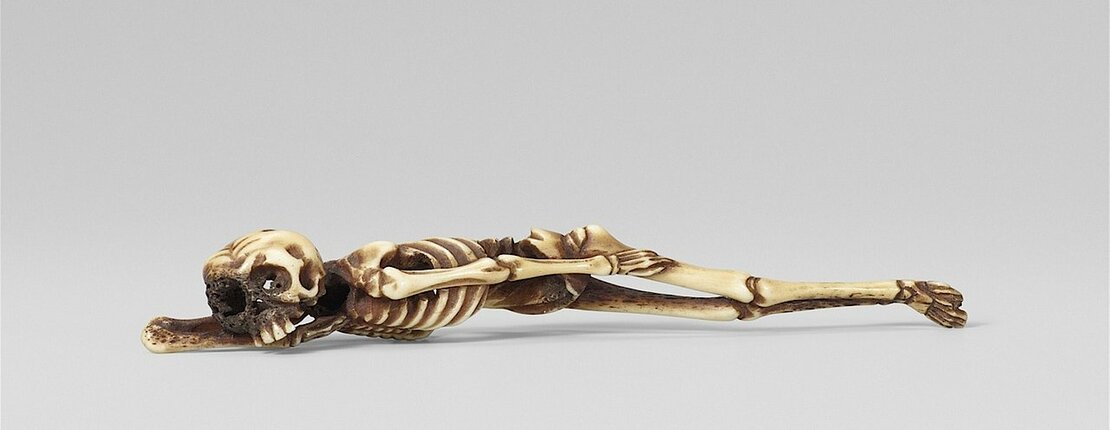
The Estate of a famous German Cardinal
Lempertz was honoured to be allowed to auction a part of the great Cardinal Meissner estate in 2018, the proceeds of which were donated to the Cardinal Meissner Foundation. The highlight of the estate was undoubtedly the Triptych altar of the Madonna Enthroned by the Master of Tobias which changed hands for nearly 500,000 euro.
Valuation of inheritance - in one of our representative offices around the world
We have offices and representatives across Europe, the USA and in South America and are happy to assist you in any of these locations. You can arrange appointments directly with the individual departments or with the respective branch office nearest to you. For larger collections we are happy to visit you at home and can offer a non-binding and discrete initial estimation or estate valuation on site. In the event of an agreement, your collection will be transported to our head office in Cologne and with the help of state-of-the-art tools, our experienced employees, and professional expertise, will be appraised and valued.
All the items you wish to sell from your collection will be examined in precise detail by our expert team. Once the examination and valuation of your collection is complete, we will inform you of the individual estimates of your items. We are happy to arrange worldwide transportation of your artworks, in particular large and heavy pictures or sculptures, through one of our professional logistics partners. Cataloguing and provenance research will begin as soon as agreement is reached. It will be ascertained if there were any interesting previous owners in the history of the work and from where the work originated, and several high-resolution photographs will be taken for the catalogue and the website.
Individual catalogues and auctions for important collections
Depending on the scale of your collection, it may be possible to initiate a special separate catalogue and auction exclusively for your objects and works of art. This concept has been proved by the many very successful auctions in recent years such as the extensive "Kolodotschko“ netsuke collection, the photography collection "Das Neue Bauen im Spiegel Der Photographie“ and the "Hoftstätter Collection“ from the Austrian art dealer Reinhold Hofstätter, as well as many important corporate collections.
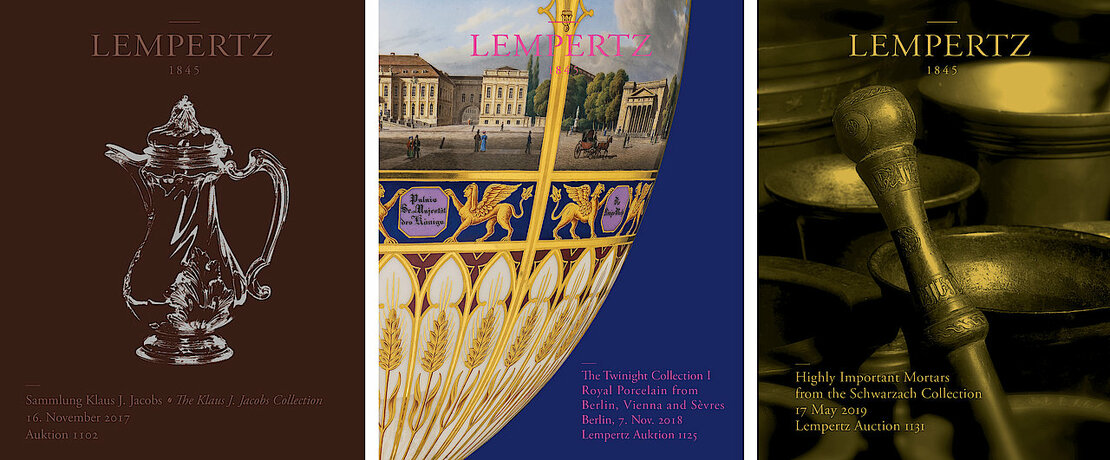
The sale of a collection or an estate - we ensure the greatest possible sales success
According to the type and value of your collection, the sale will take place in accordance with our seasonal auction calendar and may also be held on the same day as the corresponding main auction of the respective department. Should you own a very large collection of contemporary works or art, these will be sold, depending on number and total value, either in our main auction or in their own sale on the same day or weekend. This way we guarantee the greatest possible attention for your collection.
If you are considering selling or having your collection valued, please do not hesitate to contact us. The world’s oldest family-run auction house with nearly 200 years of experience is at your disposal.
Successfully sold collections or parts of collections from recent years:
- The Hofstätter Collection
- Reportage Photography 1945-1990 - The Elke and Werner Zimmer Collection
- The Kolodotschko Collection of Netsuke
- The International Style through the Eyes of Photography. Works from an Important Collection
- Hommage to Coco Chanel
- The Grünert Collection Oriental Works of Art from Belgian Collections
- Lempertz projects - selections from two important corporate collections
- The Klaus J. Jacobs Collection
- Heinrich Kühn - 60 Photographs
- The Papp Collection of Netsuke
- The Twinight Collection I & II
- Highly Important Mortars from the Schwarzach Collection
